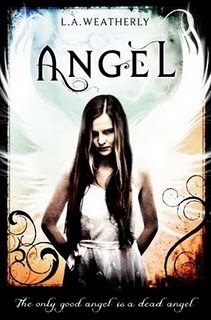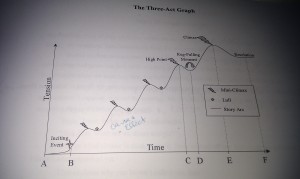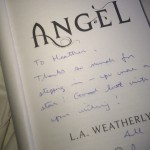 ‘The only good angel is a dead angle’ Wow! Author Lee Weatherly had me hooked. I plucked her book, Angel , from the bookstore shelf, ready to lose myself in a world where angels fed off the life force of humans. I loved the idea of evil angels. I wasn’t disappointed. If you like paranormal romance that’s original, and a female character who is anything but weak, read Angel. You’ll love it.
‘The only good angel is a dead angle’ Wow! Author Lee Weatherly had me hooked. I plucked her book, Angel , from the bookstore shelf, ready to lose myself in a world where angels fed off the life force of humans. I loved the idea of evil angels. I wasn’t disappointed. If you like paranormal romance that’s original, and a female character who is anything but weak, read Angel. You’ll love it.
When, SCBWI (Society of Children’s Book Writers and Illustrators Scotland announced they needed someone to host a writing workshop with Lee, I jumped at the chance. Although the organization would prove stressful at times, it was totally worth it.
 On Saturday, I arrived at the McDonald Road Library in Edinburgh with my laptop, projector, tea, coffee, muffins, and camera in hand, excited about meeting Lee and picking her writerly brain along with seven other attendees. I shivered as soft drops of rain trickled down my neck. The sky looked menacing, a perfect day to spend indoors learning about the craft. I pulled up the hood of my winter coat and juggled everything down the street and through the front doors of the library. I had every intention of documenting the event, but was so busy setting up and getting everyone settled, that I forgot to take pictures! (Sorry Courtney) I thought about drawing pictures for you, but I’m not an illustrator, and an abstract stick figure drawing of me with Lee wouldn’t quite have the same effect. So you’ll have to settle for pictures in words instead. I’m a writer, after all. Words are my signature dish.
On Saturday, I arrived at the McDonald Road Library in Edinburgh with my laptop, projector, tea, coffee, muffins, and camera in hand, excited about meeting Lee and picking her writerly brain along with seven other attendees. I shivered as soft drops of rain trickled down my neck. The sky looked menacing, a perfect day to spend indoors learning about the craft. I pulled up the hood of my winter coat and juggled everything down the street and through the front doors of the library. I had every intention of documenting the event, but was so busy setting up and getting everyone settled, that I forgot to take pictures! (Sorry Courtney) I thought about drawing pictures for you, but I’m not an illustrator, and an abstract stick figure drawing of me with Lee wouldn’t quite have the same effect. So you’ll have to settle for pictures in words instead. I’m a writer, after all. Words are my signature dish.
Lee arrived a few minutes after I did. Early! I wanted to have the room set before she arrived, but she lent a hand arranging the tables and chairs in a u shape. Thanks, Lee!
Lee Weatherly was Born in 1967, she grew up in Little Rock, Arkansas, USA. She moved to England 15 years ago and now lives with her husband in Hampshire where she writes, goes on walks, collects frogs, and has a cat named Bernard. When Lee shares with us that she has published over 40 books for children, ranging from Picture Books, series fiction, middle grade, and young adult, I’m amazed. I had no idea she’s written so much. She also writes under the pseudonyms L.A. Weatherly, Kitty Wells, and Titania Woods.
Here are a few key things we learned from Lee.
1) What should you write? This is from an e-mail Lee received from a published friend of hers sating what her agent told her to write about. ‘Write anything you want to write because right now no one is looking for anything, so rather than follow the market it’s better to write what you really want to (apart from magic animals and horses and young boy fiction and dystopia). It’s got to have a point of difference from everything else out there, have compelling voice, tone, character, an original twist and be something that will make an editor take it even though their lists are full. Preferably it should be funny and middle grade…’ The point is, write what’s in your heart and stop worrying about the market, you can never predict where the trends are going to go.
2) Story Structure: Have some! Lee uses a three-act graph to help her plot her structure. She also suggests using note cards to write down the important scenes and laying them out on the floor to see if the structure is working. Here’s an example of a three-act graph
AF: The overall goal or problem. What the main character wants, or is trying to achieve.
AB: Act One: the set-up. The character’s ordinary life is briefly established here, along with setting, time and place.
B: The inciting event. The event that changes everything, propelling the main character into Act Two. (It’s common to begin with the inciting event, and fill in backstory information as you go.)
BC: Act Two: conflict, attempts to overcome. Tension is escalating as the main character strives to reach his goal or solve the problem. There is cause and effect linking the story’s events, along with mini-climaxes and lulls as the story moves forward through the main character’s efforts or reactions. You should have at least three important plot points/ attempts to overcome, including C.
C: The high point. Things are looking good for the main character. He’s going to succeed!
CD: Rug-pulling moment. By a twist we never saw coming, it all goes horribly wrong.
D: The hero’s darkest moment. How will he ever succeed now? End of Act Two.
E: Climax. The do-or-die moment, the exciting showdown. The hero’s last chance to win against his obstacle: if he doesn’t succeed now, he never will. Tension is at its absolute highest.
EF: Resolution. The aftermath. We briefly take stock, tie up any loose ends, and depart.
3) Characterization: Character is very important in children’s writing, almost more important than plot. Don’t try to invent a character, it will ring false. Let the character speak to you, get to know them, listen to what they have to say.
4) Dialogue: Just because you love everything your characters have to say, doesn’t mean everyone else will. Make sure the dialogue rings true, but keep the pace of the story going. Avoid trying to make it sound the way people really talk, it’s too confusion. But don’t make it too formal either. Read the dialogue out loud, if you get tripped up reading it, it still needs work.
5) Show don’t tell: Do your best to get rid of adverbs, passive voice, and emotion words. Don’t tell me Beth loves Jason, show me in her actions towards him. This makes a much stronger story.
Fabulous day! And she signed my copy of Angel. Woo hoo!
Wish you could have all been there.
If you want to learn more about writing from Lee, pick up her book, How to Write a Blockbuster.
Thanks, all! Hope you had a wonderful weekend.
Have you been to any workshops or conferences? Do you have any recommendations on books about writing? Share in the comments.


I love L.A. Weatherly’s Angel Burn and so does my daughter. I had no idea she wrote under so many different names with so many books available. I will have to check my library to see if I can read more of her work!
I was wondering if you could repost the 3-act graph. It doesn’t seem to appear in your blog, and I’m very interested in seeing an example. Thanks!
Samantha, thank you for saying the graph wasn’t there! I will post it now 🙂 Thanks for stopping by. Lee is awesome!
So happy you had a great and energizing day! It’s funny how much all of Lee’s advice is coming into play for me in my rewrite (which I’ve been buried in lately). I always considered myself pretty good about showing, not telling, It took other eyes to point out some of my telling rather than showing, but it’s fun to fix!
I sure wish I could’ve come. I saw the graph wasn’t there earlier, so I should’ve said something. Glad Samantha did, and glad I found a few minutes to come back and see it. I’m loving breaking my story down using story structure, then utilizing it to ramp up the elements. Great post, Heather! Thanks for sharing your wonderful day!
Vaughn, I’m the same! I think I do pretty well with showing, not telling, but going back through my MS, I see tons of places where I can improve. I’m looking forward to finishing these rewrites and handing it over to some fresh eyes for a crit.
I’m glad you came back as well. The three-act graph is an amazing tool! I found it really helpful breaking down my WIP this way. I can’t believe I forgot to put it in first time around. That’s what I get for being in a hurry, trying to get it posted before dinner and choir rehersal. 🙂
Interesting post. I love all the tips!